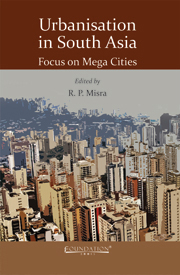Book contents
- Frontmatter
- Contents
- List of Figures
- List of Tables
- List of Contributors
- Introdution
- 1 South Asia: Land, People, and Economy
- 2 Historical Roots of South Asian Urbanisation
- 3 Mumbai: The Financial Capital of India
- 4 Delhi: Growing Problems of a Growing Megalopolis
- 5 Calcutta: The Emergence of Colonial Settlement into Megacity of the East
- 6 Chennai: A Rural Metropolis in Search of Modernity
- 7 Hyderabad: From the Feudal City to a Hi-Tech Metropolis
- 8 Bangalore: From Garden City to Silicon Valley of India
- 9 Karachi: The Commercial Capital of Pakistan
- 10 Lahore: The Cultural Heart of Pakistan
- 11 Kabul: A City in Perpetual Turmoil
- 12 Dhaka: A Mega City of Persistence and Change
- 13 Kathmandu: A City Where Tradition and Modernity Overwhelm Each Other
- 14 Thimphu: The City of Peace and Organic Development
- 15 Colombo: The Primate City of Sri Lanka
- 16 Male: Island Capital of an Island Nation
- 17 Beyond the Present: Vision of a New Urban Future
- Index
5 - Calcutta: The Emergence of Colonial Settlement into Megacity of the East
Published online by Cambridge University Press: 05 September 2013
- Frontmatter
- Contents
- List of Figures
- List of Tables
- List of Contributors
- Introdution
- 1 South Asia: Land, People, and Economy
- 2 Historical Roots of South Asian Urbanisation
- 3 Mumbai: The Financial Capital of India
- 4 Delhi: Growing Problems of a Growing Megalopolis
- 5 Calcutta: The Emergence of Colonial Settlement into Megacity of the East
- 6 Chennai: A Rural Metropolis in Search of Modernity
- 7 Hyderabad: From the Feudal City to a Hi-Tech Metropolis
- 8 Bangalore: From Garden City to Silicon Valley of India
- 9 Karachi: The Commercial Capital of Pakistan
- 10 Lahore: The Cultural Heart of Pakistan
- 11 Kabul: A City in Perpetual Turmoil
- 12 Dhaka: A Mega City of Persistence and Change
- 13 Kathmandu: A City Where Tradition and Modernity Overwhelm Each Other
- 14 Thimphu: The City of Peace and Organic Development
- 15 Colombo: The Primate City of Sri Lanka
- 16 Male: Island Capital of an Island Nation
- 17 Beyond the Present: Vision of a New Urban Future
- Index
Summary
Calcutta's (now named Kolkata) settlement history is not that old. The origin of the settlement may be attributed to the middle of the seventeenth century. During that early period, traders of Saptagram (a port-city on the upstream of River Hooghly, located farther north to Bandel, at the confluence of River Saraswati and Jamuna, both now defunct) began to seek fresh markets as their original seat declined owing to the caprices of the rivers and, thus, a few families of Sheths and Bysaks moved southward, nearer to the sea-route to Bay of Bengal, and founded the village of Gobindapur on the east bank of River Hooghly, named after the Sheths' deity Gobindaji. Northward of this, they proceeded to set up the Sutanati Hat (or cotton and yarn market) by the side of Sutanati Ghat (boat landing platform by the riverside) which eventually attracted Job Charnok, the agent of British East India Company who landed there, in search of fresh fortune, on 24 August 1690. In between Sutanati and Gobindapur was the lesser settlement of Kalikata. These three villages became the site of the original British holdings that grew into the city of Calcutta. In fact, the right of renting these three villages was granted to British East India Company by the Sabarna Roychoudhuri family of Barisha-Behala (located at the southern suburb of the then Calcutta), who were holding the zamindari rights of the area, on 10 November 1698 for Rs. 1,300 only.
- Type
- Chapter
- Information
- Urbanisation in South AsiaFocus on Mega Cities, pp. 142 - 172Publisher: Foundation BooksPrint publication year: 2012



